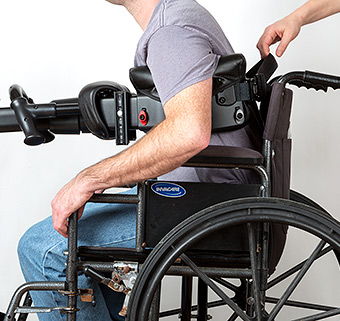The Importance of Measuring Partial Weight Bearing
| October 2012A Conversation with Sue Cecere, PT, MIT
 Rifton is pleased to have Sue Cecere, PT, MIT join us for this conversation. This topic was initiated after Sue and a fellow therapist toured our Rifton factory; they were introduced to our newest product – the Rifton TRAM. One of the features on this transfer and mobility device is a scale. In addition to simple weight measurements, this scale can also measure the amount of weight a person is bearing through the lower extremities while standing or walking – an activity called off-weighting in some therapy circles. (See note below for instructions on using the TRAM scale for off-weighting).
Rifton is pleased to have Sue Cecere, PT, MIT join us for this conversation. This topic was initiated after Sue and a fellow therapist toured our Rifton factory; they were introduced to our newest product – the Rifton TRAM. One of the features on this transfer and mobility device is a scale. In addition to simple weight measurements, this scale can also measure the amount of weight a person is bearing through the lower extremities while standing or walking – an activity called off-weighting in some therapy circles. (See note below for instructions on using the TRAM scale for off-weighting).
Sue told us that having a way to measure and track a client’s weight-bearing capability is very helpful in the pediatric setting.
Rifton: Why do you feel weight-bearing ability is an important metric?
Sue: The development of weight bearing abilities supports IDEA 2004 and the development of independent living skills in the area of personal hygiene; this can be a goal or objective on a student’s IEP. Many of our students need to develop weight bearing abilities so they can participate in their personal hygiene routines at school. Additionally, having some level of weight bearing ability can open doors for placement after a student turns 21, leaves the special education environment and wants to get out in the community with peers and families. Using the Rifton TRAM is a way to track progress on the development of this skill and can be used as a data point in the discussion.
Rifton: Is the capability of equipment to measure a client’s weight-bearing ability an important consideration when writing letters of medical necessity for equipment?
Sue: Weight bearing is considered a methodology for maintaining bone and joint health and can be used as rationale or justification .
Rifton: Other than the TRAM scale, are there other ways to measure the weight-bearing status of a student? How have you done it in the past?
Sue: When you are talking about an individual who needs a lot of support from another person to do any standing, there really is no good way to get an accurate measure of how much weight they are putting through their lower extremities. By supporting the individual entirely, the TRAM frees the caregiver to get an accurate measure using the TRAM scale.
Rifton: Thank you Sue. It is good to be reminded how working on weight-bearing skills is key in improving a student’s participation in the classroom and in activities of daily living. This is certainly in support of the ICF’s goals.
Using the Rifton TRAM Scale to Show Weight Bearing
To measure a person’s off-weighting, or partial weight-bearing capacity, simply raise the client so that the TRAM is bearing his or her full weight. Then, press the “zero” button on the scale. Now as you lower the TRAM to allow the client to bear some weight, the readout on the scale will be the amount of weight being borne.





